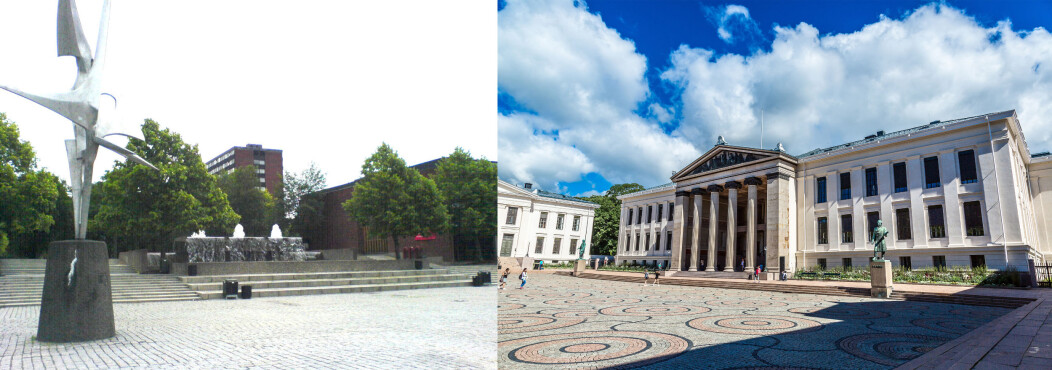Ledig stilling på Universitetet i Oslo
Blindern og Urbygningen (Foto: Wikimedia og Colourbox)
Principal Engineer in ArtsDatabanken project - Natural History Museum
Deadline: 22.11.2020
Universitetet i Oslo
The University of Oslo is Norway’s oldest and highest ranked educational and research institution, with 28 000 students and 7000 employees. With its broad range of academic disciplines and internationally recognised research communities, UiO is an important contributor to society.
The Natural History Museum at the University of Oslo is Norway’s most comprehensive natural history collection. For almost 200 years, specimens of animals, fungi, plants, rocks, minerals and fossils have been collected, studied and preserved here. The museum is located at Økern and in the beautiful Botanical Garden, which is not only popular for recreation, but is a scientific collection in itself.
About the position
A part-time position as Principal Engineer (80%) is available at the Natural History Museum (NHM), University of Oslo for two years. The expected starting date is 01.04.2021.
The Prinicipar Engineer will be part of the recently founded ArtsDatabanke-project “Assessing biodiversity in the marine algae belt”. The marine algae belt comprising kelp forests, seagrass meadows and rocky reefs with coralline red seaweeds is one of the most active primary producing environments in the sea. It also harbors are great diversity of animals including sea squirts, ribbon worms, nick worms, serpulid worms, spionid worms and ghost shrimps. The species of these groups occupy important ecological functions as herbivores, predators and filter-feeding organisms and can be sessile or agile as well as solitary or colonial. Globally these taxa comprise more than 7,000 species with around 250 species documented from Norwegian waters. Despite this the knowledge about their taxonomy and distribution in Norway is at best poor and in dire need of improvement. Specimens in museum collections are often quite old material, which additionally is often uncertain determined due to unresolved taxonomic issues including the high degree of cryptic species in these groups. Besides cryptic species, many of these taxa include invasive species causing among others high economic damage in aquaculture and ship transportation due to biofouling.
This is why we will conduct a field inventory in this habitat and collect species of these taxa in Norway (from the Skagerrak up to 70°N). With morphological and molecular methods, we will determine the species and learn more about their distribution (including reports from history and now) and their association with Norwegian nature types. Therefore, we also want to revise the existing museum collections in Norway. Through the project, we will contribute to basic biosystematics and species distribution research in general, and more specifically and importantly to red lists or other nature conservation management actions (e.g. updated information on distributions of invasive and native species including cryptic ones and their preferred habitats).
The Natural History Museum has a modern DNA laboratory as well as microscopic infrastructure needed for the project. The position will be associated with the research group “Frontiers in Evolutionary Zoology”, specifically Torsten Struck (Professor of Evolutionary Genomics).
Work tasks
- Sorting and identifying specimens from the different habitats to the required taxonomic level
- Photographic documentation of the species
- Cataloguing and curating the species for the scientific collections
- Determination of molecular barcodes for the different species
- Compilation of research results into reports and publications
- Field sampling (by boat, snorkeling, diving)
Qualification requirements
- Applicants must hold at least a Bachelor’s degree or equivalent in biology.
- We seek a person with strong motivation for research in marine invertebrates.
- The candidate must be skilled in sorting, identifying and curating of invertebrates, preferably marine ones.
- Experience with molecular-biological methods is preferable.
- Taxonomic knowledge in one of the projects groups (i.e., Tunicata, Nemertea, Kamptozoa, Serpulidae, Spionidae or Caprellidae), possession of a diving licence and/or work experience in a museum is advantageous.
- Communication skills (including written and spoken English)
We offer
- Salary NOK 416 400 – 482 200 per annum in full time position (100%) depending on qualifications in a position as Principal Engineer (position code 1085)
- A friendly working environment, which is close to both the city center of Oslo, a vibrant and international city, which )is nice to live in, and to nature parks and mountains
- Full funding of the project-related activities, including molecular lab work and participation on field trips
- Training in the different animal groups including stays with our international cooperation partners
- Flexibility with the arrangement of the working hours
- Membership in the Norwegian Public Service Pension Fund
- Attractive welfare benefits
How to apply
The application must include:
- Cover letter statement of motivation
- CV (summarizing education, positions and academic work)
- Copies of educational certificates (academic transcripts only)
- List of reference persons: 2-3 references (name, relation to candidate, e-mail and phone number)
The application with attachments must be delivered in our recruiting system.
Formal regulations
According to the Norwegian Freedom of Information Act (Offentleglova) information about the applicant may be included in the public applicant list, also in cases where the applicant has requested non-disclosure.
The University of Oslo has an agreement for all employees, aiming to secure rights to research results etc.
Contact information
- Professor Torsten Struck, phone number:+47 22851740, e-mail: t.h.struck@nhm.uio.no
Questions regarding the recruiting system: HR-Adviser Thomas Brånå: thomas.brana@nhm.uio.no
Apply for position















